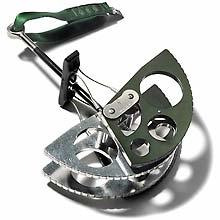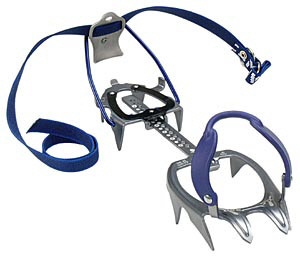 | CAMP XLC Crampons -- When
I bought these in 2004, they were the lightest 12-point crampons in
the world (all of 470 grams) and they may still be. I've used them on
a number of snow climbs in Colorado and they have performed fairly
well. The downside is that they are aluminum and don't hold an edge.
Yes, I have done technical ice in these things, but I definitely
wouldn't recommend it. Flexing, dull frontpoints do not inspire
confidence. Nor are they ideal for kicking steps in steep, hard snow.
However, for their intended purpose, they work very well; moderate
snow climbs where strong and sharp points are not required. I use the
hybrid binding system (universal front, step-in rear, the XLC470
model) which attach to my heavy hiking boots. In retrospect, I wish
I'd gone with the strap-on model so I could use them with lighter
footwear. |
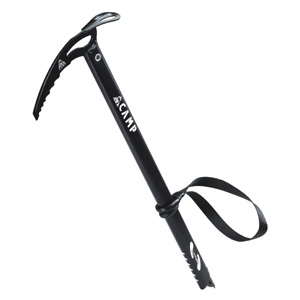 | CAMP Altitude Ice Axe --
This has been my main axe for three years now. It is very light and
has served me well, but, as my mountaineering level increases, I begin
to see it's limitations. The pick is fairly short compared with
comparable axes and self arrests are not quite as secure as they could
be. The adze is similarly small and not really suitable for chopping
away ice. The aluminum spike is marvelously light, but can't be
sharpened and won't penetrate hard snow when you need it most. After
three seasons of hard use, the rivet holding the spike to the shaft
sheared away. I note with interest that CAMP now features steel
spikes on many of their axes. Still, this axe is great for what it
was designed for: moderate snow slopes, glissades, and traverses. My
needs have outgrown my axe. Amy has the freakishly light (9 oz)
XLA210 which is identical except that it has an aluminum head
(and is 10cm shorter). |
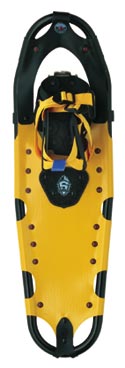  | Sherpa Climber Snowshoes
-- Big, stompy snowshoes (8x30"). I've used these in various
conditions now from deep powder to packed trails and found them to be
good but not ideal. Flotation is excellant and the nylon-wrapped
frame gives a little more purchase when going uphill or down.
However, they don't traverse well and tend to slip latterally. The
metal bar hinge lets them rotate freely and stay parallel to the
ground. The big, aluminum cleats on the bottom provide ridiculous
grip on packed snow, but tend to ball up at the slightest provocation.
The binding system is lovely and simple and is a breeze to put on.
Requires periodic tightening, but that's life. The downsides are that
they're big enough, they're hard to carry on my pack. Also, the
bindings are such that my toes tend to ride up over the aluminum toe
bar and catch on the decking material. I have solved this with a
metal strap from the front of the toe bar to the webbing across my
insteps. Note: Sherpa appears to be out of business now, so these may
become collectors items, of a sort. |
 | MSR Denali Classic
Snowshoes -- I got these last season to replace my failing
Sherpas. They are a very different paradigm with the plastic decks,
but seem to be the standard around here for winter mountaineering.
They are smaller and lighter than my old Sherpas, but climb much
better, are much simpler, and traverse very well. The downside is
that they are loud and have much less flotation than larger shoes. I
own flotation tails for them, but have yet to try them out. Another
advantage is that they are much cheaper than most other snowshoes out
there. |
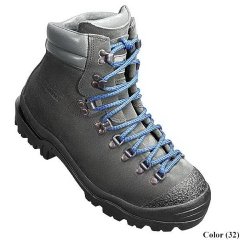 | Montrail Moraine
Boots -- I owned a pair of these from 1996 when Montrail
was still OneSport and loved them dearly. They fit straight out of
the box and provided ample support over hill and dale, ice and scree
for seven years. In 2003, they finally split down the middle of the
sole (!!!) and had to be retired. I replaced them with the updated
model which is considerably beefier and heavier duty than the old
version. I'll admit that these boots may not be for everyone; they
are quite heavy and entirely more macho than neccessary for simple
hiking and most anything out east in the summer. Here in Colorado,
I've found them to be good off-trail hikers in the summer, good in
snow and even for moderate mountaineering. They are stiff enough for
flexible crampons and step-kicking, yet flexible enough for hiking
comfortably for short trail distances (less than 10 miles). The new
versions have a heel bail for crampons (see above) and a plastic
tongue plate to spread the load out on the foot. Other peoples'
reviews have been decidedly mixed, but they fit my medium width, high
arch, medium volume feet quite well. Technically, they edge like
demons on steep rock and are fairly warm. I have lead up to 5.6 in
them without much fear. Now the downsides: they are hideously
uncomfortable for long days of flat trail. |
 | Leki Super-Makalu Hiking Poles -- I've been using
these poles for a decade now and have almost no complaints. Now on my
second pair, they have saved my bacon a number of times both
figuratively and litterally. My only complaint is that the locking
mechanism sometimes won't lock without a good deal of finagling (the
BD system may be superior in this regard). Worth every penny and
ounce. I recently retired my old poles and purchased the updated
version. The shocks now have two settings and the straps are more
easily adjustable. Other than that, they are the same great
poles. |
 | Lowe
Alpine Outback-70 Backpack -- They don't make this pack
anymore which is extremely unfortunate. It is a no-frills,
light-weight internal frame pack perfect for my needs and a pleasent
purple color to boot. The sleeping bag compartment on the bottom is
separated from the main compartment by a zippered divider. The
suspension system is nicely adjustable without being extremely heavy.
The hip belt is not as padded as some folks might like and the
stuffing in the butt pad has shifted around a bit. You've got to pack
a little carefully or else sharp things in the pack can poke through
into your back, but it is otherwise completely worth it. I've humped
this pack over 500 Appalachian Trail miles and across four
continents (those being Africa, Europe, and the Americas). I've seen
several thru-hikers on the AT with the same or similar packs and they
were still having a good time as far north as New Hampshire. |
 | MSR
Dragonfly Stove -- This is the Cadillac of white-gas
stoves. It's heavy and expensive, but cooks beautifully and reliably.
The simmer option really does work and I can get a flame anywhere in
the range of silent candle flame to roaring jet engine easily and with
great finesse. The disadvantages are, obviously, that it's heavy and
expesive, and that it must be coddled a bit when turning it on. You
have to prime it carefully: let a little fuel out into the bottom and
burn it. When the fuel has practically burned away, open the valve
slightly and start cooking. You have to turn it up slowly or else you
get exciting fuel-air fireballs which shoot out. Takes about thirty
seconds to warm up properly but performs like a champ after that. I
don't usually take it when I'm out by myself, but it does nicely for
group trips where gourmet cooking is a higher priority. There is a
new stove (the Simmerlite?) put out by MSR which is similar to the
Dragonfly in terms of cooking control, but about 1/3rd the weight. If
I were to get a new stove today, it would probably be something like
this. Update: the weakness of this stove (and many MSR stoves, I
suspect) is the plastic pump. I've broken two pumps now which leads
to various blue language in the backcountry. |
 | TNF
Cats Meow Sleeping Bag -- Pros: light, comfortable. Cons:
doesn't even come close to the advertised 20-degree temperature rating
and doesn't hold it's loft after even moderate use. Anything even
approaching freezing than freezing and I'm left wishing I'd brought my
down bag. This may be partially my fault as I left it in its sack for
a solid month during a trip to Patagonia and the fill has noticably
compressed. But I know half a dozen other people with this bag and
they all hate it. At this point, this is my summer bag and I'll bring
my down for anything in the other three seasons. |











